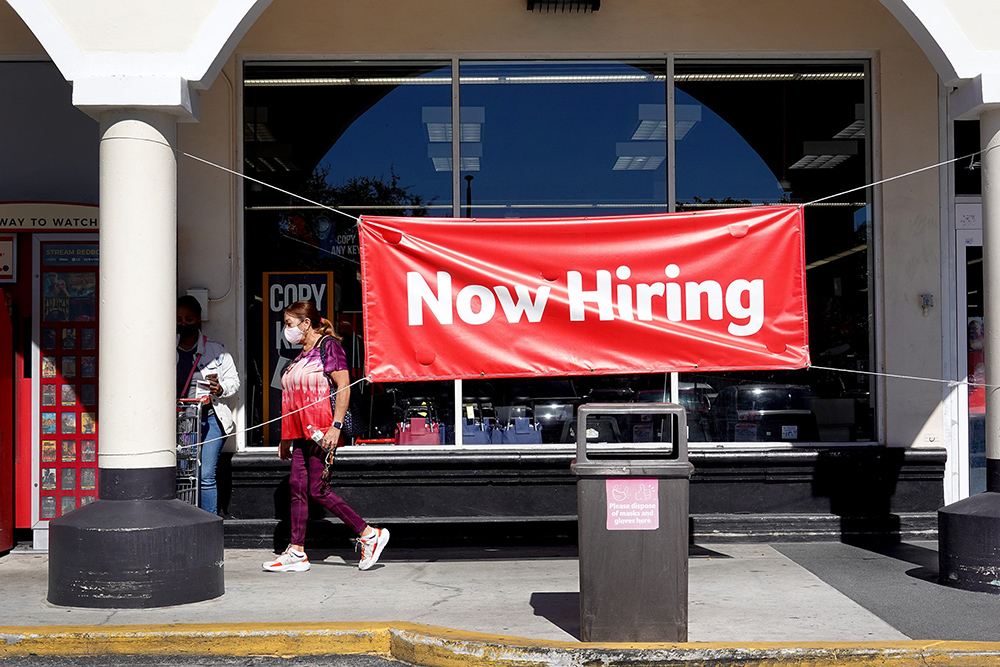
想要實現軟著陸嗎?試試推進性別平等議程。通過縮小美國勞動力市場的性別平等差距,可以幫助政策制定者實現夢寐以求的軟著陸。這樣做,我們可以從公平的勞動力市場中獲得1.789萬億美元的收益。
當我們通過交叉性視角來看待經濟時——也就是說,當我們按性別加上種族和民族來分列經濟數據時,有趣的事情發生了。就在疫情爆發之前,女性的勞動參與率已攀升至59.2%。截至2022年10月的就業報告,這一比例已降至58%。當我們從控制人口增長的百分比角度考慮這一問題時,這意味著自2020年2月以來,有154.9萬女性從勞動力大軍中消失了。
這讓我感到不安,而我的不安不是來自公平問題。我不是激進分子。我是一名性別經濟學家——我們的經濟實力源于勞動力大軍的多元化。我們需要那一百多萬從勞動力大軍中消失的女性來為我們的經濟引擎注入動力。自1970年以來,女性通過提高勞動力參與率為美國經濟貢獻了2萬億美元的價值。
以萬億美元計的經濟機會被疫情抹殺了
在疫情爆發之前,縮小勞動力參與率方面的性別差距可以為美國經濟帶來約7890億美元的收益,而除此之外,自1970年以來,我們已經獲得了2萬億美元的收益。
然而,在過去的兩年時間里,29年來在勞動力市場性別平等方面取得的進展付之東流。這種倒退潛在上使美國經濟損失了1.789萬億美元。換句話說,縮小勞動力市場上的性別平等差距可以為疫情后的美國經濟提供1.789萬億美元的支撐。
如果我們在10月份的失業數據中計入勞動力市場中缺失的154.9萬女性,那么女性的實際失業率將為5.42%。通過交叉性視角,情況看起來要暗淡得多。對非裔女性來說,包括自2020年2月以來從勞動力市場上消失的32.8萬名非裔女性,失業率為8.58%。對拉丁裔來說,包括自2020年2月以來從勞動力市場上消失的31.3萬女性,失業率為6.03%。我們的政策不僅沒有考慮到這些女性,而且也不太了解她們離開勞動力市場的原因。我們無法獲得相關數據——但經濟學家確實懷疑其中許多人進入了非正規經濟。
這些令人眩暈的交叉失業率不僅與美聯儲實現最大充分就業的目標相悖(目標失業率在4.1%到4.7%之間),也與經濟繁榮原則相悖。
如果我們不是通過大幅加息來給經濟降溫,而是通過制定解決方案讓這些女性重返勞動力市場呢?這樣做將得到一個應對軟著陸挑戰的三步走方案:該方案將穩定物價,鼓勵公平就業,并促進經濟可持續增長。
性別平等是實現經濟軟著陸的關鍵
實現軟著陸需要遵循三步走原則。讓我們回顧一下這一舞蹈的編排。
首先,經濟升溫,通貨膨脹上升。10月份的物價較上年同期上漲7.7%。
其次,美聯儲加息,給經濟降溫。美聯儲在短短8個月內將聯邦基金利率提高了375個基點。
第三,物價維持穩定,避免經濟衰退。如果我們選擇讓這154.9萬女性重返勞動力市場,我們就有希望實現軟著陸。原因如下。
公平就業帶來的經濟效益
在美國經濟中,每個找工作的人都對應有約兩個空缺職位。勞動力供給增加將使員工與空缺職位之間的差距縮小近33%。通過減輕工資-物價螺旋上升帶來的有害影響,更多的員工爭搶不斷減少的工作機會,這將有助于抑制通貨膨脹。
為了避免經濟衰退,需要將所有交叉群體的失業率保持在4.1%到4.7%的最大充分就業的目標范圍內。正如按性別和種族分列的數據所顯示的那樣,有意讓非裔和拉丁裔女性重返勞動力市場,將確保在一個已經顯現出最嚴重的經濟分層的國家,不會出現持久的K型復蘇。
總體而言,進一步加息對公平就業來說不是好兆頭。緊縮的貨幣政策導致公司按照“后進先出”的原則整合勞動力。這意味著女性和非裔雇員通常是最先被解雇的。
新的研究表明,從公平的勞動力市場中獲得1.789萬億美元的收益是一個保守的預測,因為用來計算這一數字的模型依賴于所謂的職員總數衡量方法。它對每個“人頭”都一視同仁。一位員工就是一位員工。
然而,在勞動力市場上,女性和男性并沒有完美的替代品。增加一個特定業務部門的性別多樣性會改善公司的財務業績,而這種改善是模型無法體現的。
例如,我所在的公司的研究表明,交叉性的性別平等每增加10%,收入就會增加1-2%。當模型將性別平等考慮在內時,女性勞動力貢獻的經濟收益可能多達五分之一。(財富中文網)
本文作者卡蒂卡·羅伊(Katica Roy)是Pipeline公司的首席執行官。
Fortune.com上發表的評論文章中表達的觀點,僅代表作者本人觀點,不代表《財富》雜志的觀點和立場。
譯者:中慧言-王芳
想要實現軟著陸嗎?試試推進性別平等議程。通過縮小美國勞動力市場的性別平等差距,可以幫助政策制定者實現夢寐以求的軟著陸。這樣做,我們可以從公平的勞動力市場中獲得1.789萬億美元的收益。
當我們通過交叉性視角來看待經濟時——也就是說,當我們按性別加上種族和民族來分列經濟數據時,有趣的事情發生了。就在疫情爆發之前,女性的勞動參與率已攀升至59.2%。截至2022年10月的就業報告,這一比例已降至58%。當我們從控制人口增長的百分比角度考慮這一問題時,這意味著自2020年2月以來,有154.9萬女性從勞動力大軍中消失了。
這讓我感到不安,而我的不安不是來自公平問題。我不是激進分子。我是一名性別經濟學家——我們的經濟實力源于勞動力大軍的多元化。我們需要那一百多萬從勞動力大軍中消失的女性來為我們的經濟引擎注入動力。自1970年以來,女性通過提高勞動力參與率為美國經濟貢獻了2萬億美元的價值。
以萬億美元計的經濟機會被疫情抹殺了
在疫情爆發之前,縮小勞動力參與率方面的性別差距可以為美國經濟帶來約7890億美元的收益,而除此之外,自1970年以來,我們已經獲得了2萬億美元的收益。
然而,在過去的兩年時間里,29年來在勞動力市場性別平等方面取得的進展付之東流。這種倒退潛在上使美國經濟損失了1.789萬億美元。換句話說,縮小勞動力市場上的性別平等差距可以為疫情后的美國經濟提供1.789萬億美元的支撐。
如果我們在10月份的失業數據中計入勞動力市場中缺失的154.9萬女性,那么女性的實際失業率將為5.42%。通過交叉性視角,情況看起來要暗淡得多。對非裔女性來說,包括自2020年2月以來從勞動力市場上消失的32.8萬名非裔女性,失業率為8.58%。對拉丁裔來說,包括自2020年2月以來從勞動力市場上消失的31.3萬女性,失業率為6.03%。我們的政策不僅沒有考慮到這些女性,而且也不太了解她們離開勞動力市場的原因。我們無法獲得相關數據——但經濟學家確實懷疑其中許多人進入了非正規經濟。
這些令人眩暈的交叉失業率不僅與美聯儲實現最大充分就業的目標相悖(目標失業率在4.1%到4.7%之間),也與經濟繁榮原則相悖。
如果我們不是通過大幅加息來給經濟降溫,而是通過制定解決方案讓這些女性重返勞動力市場呢?這樣做將得到一個應對軟著陸挑戰的三步走方案:該方案將穩定物價,鼓勵公平就業,并促進經濟可持續增長。
性別平等是實現經濟軟著陸的關鍵
實現軟著陸需要遵循三步走原則。讓我們回顧一下這一舞蹈的編排。
首先,經濟升溫,通貨膨脹上升。10月份的物價較上年同期上漲7.7%。
其次,美聯儲加息,給經濟降溫。美聯儲在短短8個月內將聯邦基金利率提高了375個基點。
第三,物價維持穩定,避免經濟衰退。如果我們選擇讓這154.9萬女性重返勞動力市場,我們就有希望實現軟著陸。原因如下。
公平就業帶來的經濟效益
在美國經濟中,每個找工作的人都對應有約兩個空缺職位。勞動力供給增加將使員工與空缺職位之間的差距縮小近33%。通過減輕工資-物價螺旋上升帶來的有害影響,更多的員工爭搶不斷減少的工作機會,這將有助于抑制通貨膨脹。
為了避免經濟衰退,需要將所有交叉群體的失業率保持在4.1%到4.7%的最大充分就業的目標范圍內。正如按性別和種族分列的數據所顯示的那樣,有意讓非裔和拉丁裔女性重返勞動力市場,將確保在一個已經顯現出最嚴重的經濟分層的國家,不會出現持久的K型復蘇。
總體而言,進一步加息對公平就業來說不是好兆頭。緊縮的貨幣政策導致公司按照“后進先出”的原則整合勞動力。這意味著女性和非裔雇員通常是最先被解雇的。
新的研究表明,從公平的勞動力市場中獲得1.789萬億美元的收益是一個保守的預測,因為用來計算這一數字的模型依賴于所謂的職員總數衡量方法。它對每個“人頭”都一視同仁。一位員工就是一位員工。
然而,在勞動力市場上,女性和男性并沒有完美的替代品。增加一個特定業務部門的性別多樣性會改善公司的財務業績,而這種改善是模型無法體現的。
例如,我所在的公司的研究表明,交叉性的性別平等每增加10%,收入就會增加1-2%。當模型將性別平等考慮在內時,女性勞動力貢獻的經濟收益可能多達五分之一。(財富中文網)
本文作者卡蒂卡·羅伊(Katica Roy)是Pipeline公司的首席執行官。
Fortune.com上發表的評論文章中表達的觀點,僅代表作者本人觀點,不代表《財富》雜志的觀點和立場。
譯者:中慧言-王芳
Want to stick a soft landing? Try sticking to an agenda of gender equity. By closing the gender equity gap in the U.S. labor market, we can achieve the coveted soft landing policy leaders are striving for. And in doing so, we can reap the $1.789 trillion upside of labor market equity.
Something fascinating happens when we view the economy through the intersectional gender lens–that is, when we disaggregate economic data by gender plus race and ethnicity. Right before the pandemic hit, women’s labor force participation rate had climbed to 59.2%. As of the October 2022 jobs report, the rate had dropped to 58%. When we deal in percentages that control for population growth, that means 1.549 million women have vanished from the labor force since February 2020.
This bothers me, and not for reasons of fairness. I’m not an activist. I’m a gender economist–and our economy derives its strength from the plurality of the labor base. We need those million-plus lost women to power our economic engine. Since 1970, women have added $2 trillion of value to the U.S. economy by increasing their labor force participation.
A trillion-dollar economic opportunity obliterated by the pandemic
Pre-pandemic, closing the gender gap in labor force participation could have yielded some $789 billion for the U.S. economy on top of the $2 trillion we’ve already gained since 1970.
However, in the last two years, 29 years of progress toward gender equity in the labor market has been obliterated. This regression has cost the U.S. $1.789 trillion in economic potential. In other words, closing the gender equity gap in the labor market could bolster the post-pandemic US economy by $1.789 trillion.
If we include the 1.549 million missing women from the labor market in October’s unemployment figures, women’s real unemployment rate would be 5.42%. The picture looks much bleaker through the intersectional lens. For Black women, including the 328,000 of them missing from the labor force since February 2020, the unemployment rate is 8.58%. For Latinas, including the 313,000 of them missing from the labor force since February 2020, the unemployment rate is 6.03%. Not only do our policies fail to take these women into account, but we also don’t know much about the reasons they left the workforce. The data is simply not available–but economists do suspect many of them went into the informal economy.
Not only do these vertiginous intersectional unemployment rates violate the Fed’s mandate of maximum employment (of which the target unemployment rate ranges between 4.1% and 4.7%), they also violate the principles of economic prosperity.
What if instead of yanking interest rates to cool down the economy, we craft solutions to bring these women back into the workforce? Doing so would generate a tripartite solution to the soft landing challenge: it would stabilize prices, encourage equitable employment, and fuel sustainable economic growth.
Gender equity is key to a soft landing
A soft landing follows a three-step dance. Let’s review the choreography.
First, the economy heats up and inflation rises. October’s prices were up 7.7% compared to the previous year.
Second, the Fed raises interest rates to cool down the economy. The Fed has raised the federal funds rate by 375 basis points in only eight months.
Third, prices stabilize and the economy avoids a recession. If we choose to bring those 1.549 million women back into the labor force, we can hope for a soft landing. Here’s why.
The economic benefits of equitable employment
Our economy has approximately two open jobs for every person looking for work. An expanded labor base would close the worker-to-open-job gap by nearly 33%. More workers chasing fewer jobs would keep inflation in check by mitigating the harmful effects of the wage-price spiral.
To avoid a recession, we need to keep unemployment for all intersectional cohorts within the maximum employment mandate range of 4.1% and 4.7%. As the gender and race disaggregated data show, bringing Black and Latina women meaningfully back into the workforce would ensure we don’t have a protracted k-shaped recovery in a country already exhibiting some of its most egregious levels of economic stratification.
Further interest rate hikes do not bode well for equitable employment levels in general. Tighter monetary policy causes companies to consolidate their workforces to the rhythm of “last hired, first fired.” And that means women and Black employees are usually the first to get cut.
Emerging research suggests the $1.789 trillion upside of labor market equity is a conservative projection–because the models used to calculate that figure rely on what’s known as a headcount measurement. It treats every “head” the same. A worker is a worker.
However, women and men are not perfect substitutes in the labor market. Increasing the gender diversity of a given business unit leads to improved financial performance of the firm in a way not captured by the models.
For instance, my company’s research shows that every 10% increase in intersectional gender equity yields a 1-2% increase in revenue. When models do account for gender equity, the economic gains of women’s labor force participation could be up to a fifth larger.
Katica Roy is the CEO of Pipeline.
The opinions expressed in Fortune.com commentary pieces are solely the views of their authors and do not necessarily reflect the opinions and beliefs of Fortune.






